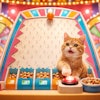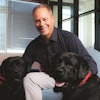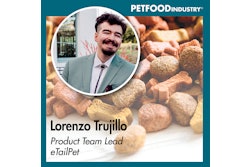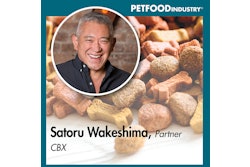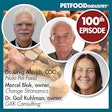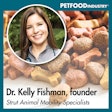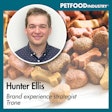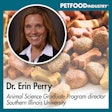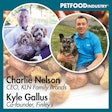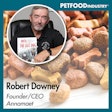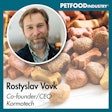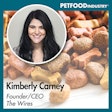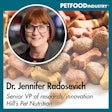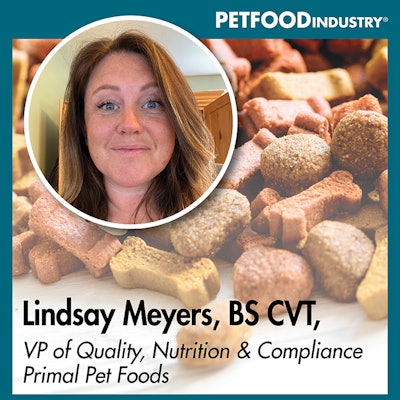
Host Lindsay Beaton talks with Lindsay Meyers, vice president with Primal Pet Foods, about the evolution of raw pet food acceptance, continuing education challenges and where this growing alternative pet food category is headed.
The below transcript is from Episode 51 of the Trending: Pet Food podcast, where editor Lindsay Beaton speaks with vice president for Primal Pet Foods, Lindsay Meyers. Together they discuss the evolution of raw pet food acceptance, continuing education challenges and where this growing alternative pet food category is headed.. You can find the episode at PetfoodIndustry.com/trending-pet-food-podcast, on SoundCloud or on your favorite podcast platform. This episode originally aired on December 20, 2023.
Lindsay Beaton, editor, Petfood Industry magazine and host, Trending: Pet Food podcast: Hello and welcome to Trending: Pet Food, the industry podcast where we cover all the latest hot topics and trends in pet food. I'm your host and editor of Petfood Industry Magazine, Lindsay Beaton. I'm here today with Lindsey Meyers, BS CBT, vice president of quality nutrition and compliance at Primal Pet Foods. Hi, Lindsay and welcome.
Lindsay Meyers, BS CBT, vice president of quality nutrition and compliance at Primal Pet Foods: Hi, Lindsay.
Beaton: In case you're not familiar with Lindsay or Primal, here's what you need to know. Lindsay has always been passionate about helping people make the best and safest choices when it comes to real food solutions for their pets’ health. A certified veterinary technician an active member of the American Academy of Veterinary Nutrition and New Hampshire Veterinary Technician Association, she has spent more than 15 years practicing veterinary medicine across emergency critical care and exotic and small animal general practice. When she joined the Primal Pet Foods’ team as a territory sales representative in 2015, she educated retail partners in New England about the brand.
Lindsay is a fierce advocate for the feeding of safe raw diet to pets and saw the opportunity to educate the veterinary community about this lesser-known category of pet food. As such, she established a veterinary outreach program that has grown the presence of the Primal brand in the veterinary community over the last six years and helped to increase the understanding of the benefits of a safe raw diet among veterinarians.
Lindsay is a champion for food safety and is a Preventive Controls Qualified Individual and HACCP-certified quality control leader. As vice president of quality nutrition and compliance for Primal Pet Foods, Lindsay oversees all aspects of quality assurance, product nutrition and formulation and regulatory affairs.
Primal Pet Foods, which was founded by Matt Koss in 2001, has always been committed to nourishing pets the way nature intended. A pioneer in the raw freeze-dried pet food categories, Primal has been crafting premium pet foods using whole food ingredients for over 20 years. With manufacturing facilities in California, Colorado and Texas, the company is focused on using production processes that best retain the natural nutrition of quality ingredients providing the highest quality of life for pets and their parents.
Lindsay is experienced with raw pet food and her passion for pet food safety are both why I've brought her on today to answer this question: Where is the industry at in terms of raw pet food safety?
The first question I'm going to ask you is a bit of a one-on-one, but if you're not in the raw pet food space, you don't necessarily know anything other than the broad strokes that we tend to cover when we talk about raw pet food. So how long has the idea of raw pet food been around? And when did it become commercialized? How long has that more formal idea been around?
Meyers: It's a great question and a great place to start with the different audiences I speak to. I often forget which history lesson is the most important to start with, and I think this one, especially for this audience, is so good because as pet industry professionals, and as pet food professionals, our perspective of the industry is much different than that of the consumer or veterinary or regulatory professional.
The reality is that raw feeding for dogs and cats has been around since dogs and cats were around. That's how they started becoming part of our homes, right? We were feeding them the scraps, they were catching our vermin, like that's how we domesticated them. So, how long has it been around is … forever. But how long has it been a commercialized industry that is as large as it is today? When did that growth start to happen? The answer is a little bit different depending on where you are.
I often point to -- and maybe this has to do with my unique perspective starting in veterinary medicine -- the point in time when Dr. Ian Billinghurst, who is a well-respected veterinarian from Australia, he wrote a book in the early 90s called “Give Your a Dog a Bone” that was about raw feeding your pet at home. That's really when the popularity of BARF model diet feeding (biologically appropriate raw foods or bones and raw foods feeding) started to hit the -- at least for me in the veterinary profession --like the mainstream.
At least from my perspective, it wasn't really commercialized in the early and mid-90s. It was mostly people doing it on their own, or at least that's what the primary persons that we were encountering in the veterinary space were creating those diets on their own just like he had guided them to, which of course led to a commercial opportunity.
Matt Koss, our founder of Primal Pet Foods, started this company over 20 years ago. In 2001 is when Primal Pet Foods started, so we've been around for almost that entire time. You know, during the growth, we're one of the original companies that started producing commercially available raw pet foods in the early 2000s. He started the company because he wanted to give more people access, more people the opportunity to feed these raw foods.
Feeding raw, whether you're doing it on your own or buying a commercially prepared diet is not always simple and it's certainly couldn't be more expensive. We often said something in sales, “If something is more expensive and less convenient, but it's growing as quickly as this one is, isn't that a sign that it must be working?” So when Matt figured out how beneficial these diets were for his own dog, who had similar to my dog, which got me into the business as well, when raw food changed his life, he felt like he needed to give more people access to this.
If you didn't feel like you had the skills to create this diet on your own, how can I prepare it? Matt's career started, he was a chef in the San Francisco area, and it made sense to him, how can I provide this to more people? How can I give them the opportunity to feed these fresh food diets in a way that's safe and more convenient? It's difficult to make your own pet food diet, whether it's raw or not.
Providing a complete and balanced safe raw pet food diet was something that he was passionate about many, many years ago, and still something that we do with all of our innovation today. How can we get more people access to fresher and rawer and minimally processed foods for their pets, because most of the industry is a highly processed pet food in order to make sure that it can be produced in mass and that it can be accessible to the most people and that we can give our dogs and cats the nutrition that they need. But that's a challenge. It's certainly a challenge when it comes to food safety.
Beaton: I want to dive right into safety, and particularly the idea of people making it on their own at home versus buying commercially. They didn't used to have the option to buy commercially. Now they do. Obviously, it's more convenient to buy it commercially because you don't have to try to put it all together, you don't have to worry about the nutritional component and that kind of thing.
Are there safety considerations that are cut out when you are suddenly able to buy it from a facility versus making it at home? Because I know at least in human food preparation, there are all kinds of food safety concerns. I'm guessing it's largely the same for pet raw food safety. Does that play a factor at all in the conversion of people from making it at home to buying raw pet foods instead?
Meyers: Certainly, yes, for some consumers, and I was one of those consumers. As a veterinary professional, I was really concerned about the balance, like you mentioned, making sure that it was complete and balanced for my pet but also making sure that it was safe.
We all understand that raw chicken, we need to cook it to a certain temperature to make it safe for our family members; that we need to clean surfaces. In the pet food industry, if you're purchasing a commercial pet food product, whether it's a bag of kibble or a can of pet food or a Primal frozen raw patty at a commercial pet food store, we must adhere to the same standard. We adhere to the same standards that a canned food or a kibble does and that's a zero tolerance for the presence of any Salmonella, E. coli or listeria.
If a pet gets sick, that means no matter what, we are not allowed to have potentially harmful bacteria in our foods. That's part of what we need to comply with to ensure that not just the pets, but the people handling the food and handling the pets who sleep in our beds – that everyone is safe and protected from potentially harmful bacteria.
I think the biggest difference when you buy raw chicken at the grocery store, it is very likely that there is harmful bacteria on that food. That's regulated by a different segment of the industry. That food is regulated with the understanding and the intention that it's to be cooked. Cooking is an inexpensive and simple way to achieve safety. Cooking will kill most harmful foodborne pathogens, Salmonella, E. coli, listeria, all can be killed by the proper temperature of cooking. That's the little disclaimer that's on the meat that we buy at the grocery store.
Now, if we're providing raw meats, can we make them pathogen-free? The answer is yes, it's challenging. It can be more expensive and certainly different from heat processing, but it's certainly achievable. There are other ways to prevent, to kill and to stop growing potentially harmful pathogens from the inside of animals’ tissue, which is what meat is. It's weird to think about. That shouldn't be contaminated with bacteria, that would mean the animal was ill, the inside of your body is sterile. That's why you need a sterile operating room. It's what keeps us healthy. Our skin protects us from the outside world. So those meats shouldn't be contaminated with a large amount of bacteria. But they can be contaminated quite easily during any point in the supply chain based on the type of animal that meat comes from. There's lots of different things that we can do to reduce that pathogen load that don't necessarily need to include heat or cooking. That's part of that process.
Beaton: When you are producing raw food, when compared with a food that goes through a heat-based kill step, what does that look like and what does the food safety process look like when you're processing ingredients when you're creating the food when you're finalizing? I'm assuming they're extra steps or at least very different steps. Then what might happen if you're depending on a heat-based kill step?
Meyers: Yes, and some of them will be similar. I think every company will have its own nuanced way of applying these control steps. I can speak to Primal. It starts at the very beginning for us, which is that sourcing. Sourcing is an important first step -- understanding where those animals are coming from, how they're being slaughtered. Then the cold chain … so the chain of command, once that cut of meat has been removed from the animal, how is that cut of meat then handled, transported and stored to ensure that it's not becoming contaminated with bacteria? Or that any potential contamination that might be there isn't allowed to grow, which is all based on the type of bacteria it is. Different bacteria’s require different things for growth. Listeria, for example, likes a really cold environment. But Salmonella likes a warm -- I always refer to a barbecue picnic. Everyone knows don't leave a mayonnaise salad out in the warm sun. You know, that's how Salmonella likes to grow. There are certain bacterial pathogens that like a warm environment, and there are some that like cold deli meat, Listeria, for example.
Understanding where your potential pathogens might like to grow and understanding what your suppliers need to do to ensure that the cold chain is held throughout so that when we get that meat product, it's got the lowest possible or zero possible load of bacterial pathogens on it from the start. Then we can apply different technologies, different hurdles, different kill steps essentially, to make sure that those bacteria are eliminated if they're there, and that they're controlled and not able to be contaminated throughout.
Starting with sourcing and throughout the production process, understanding what has been applied or not. We're talking about our frozen products which undergo HPP, or high-pressure processing, which is like a “squeezing the meat” process. High-water pressure that achieves a log reduction, so kills off bacterial pathogens, and that is really nuanced. It can really depend on the moisture content and the fat content and the pH of the food. There's a lot of things that go into account when you're thinking about how much pressure is needed to kill the bacteria that you're trying to kill without impacting the flavor, the nutrition. You can achieve high pathogen load reduction using pressure. There are a lot of industries that use pressure and heat to achieve that. Ultra-pasteurized milk is always an example that I use. They can achieve shelf-stable milk products. Now you can get like little juice boxes for your kids, but it's milk. That's a combination of heat and pressure.
You can also use really cold-water pressure to achieve that load. But again, if it's not coming into you clean, you're never going to be able to reduce it down to a level that's safe. That's going to give you that zero tolerance for pathogens that you need in order to provide a raw meat pet food that has zero presence of those harmful pathogens.
So, it starts at the supply chain and goes all the way out to end testing. Depending on the product line, we use high-pressure processing, we use sourcing, we use sanitation methods. Making sure that when we're grinding the meat and preparing it to go out for HPP, that’s at a different step and/or section of our facility so when sanitation of that equipment line or of that area of the facility is done, then it’s proven that it was effective, then we can bring in products that have already been through HPP and we know are now negative for those harmful pathogens and put them on equipment in those same areas. There are certain things we need to do to make sure that what we call “prelethality products” are not contaminating “post lethality products.” Those things are all intertwined in food safety plans and how your facilities are built and what you do for testing -- not just of the products after they're made, but of your equipment lines themselves of the products that are coming in.
There are so many things involved in making sure -- especially as you become a large manufacturing company. I'm sure the safety steps that we have today are so much different than what Matt started in the early 2000s when he was just purchasing meats from a couple of local providers that he knew. If you know the butcher, you can ensure that you're getting the cuts that you need and that things are safe. You know exactly how it's been cold-chain handled because you're right there. But when you go to mass producing these products like we are now, there's a lot that's involved with ensuring a safe product.
Beaton: I was going to ask about scaling up in batching. Because it sounds like there's so much math and science involved in particularly when you were discussing how much pressure something needs. It sounds like it might be something that gets tweaked a lot depending on the composition of the batch of whatever you're producing in any given run.
Meyers: This is why validation studies are so important, right? So you have to make sure that what you're doing is effective. I can go out to an HPP provider and say, “This is a raw meat-based pet food. What do you recommend is the time, temperature, pressure?” Then you must test it on your own products and make sure that those parameters are achieving what you need to and sort of figure out at what limits is this no longer working. A robust test and hold program and environmental monitoring program, and just ongoing research, to make sure that you're doing the most current scientifically understood thing is so important.
Certainly, you're right, our recipes have changed, although not as much as you might think. But they have changed somewhat over the years. Our batch sizes have stayed really consistent for several years. That's mostly because once you purchase large commercial equipment that can grind batch sizes, and when you're doing something like raw pet food, our batches have never really been all that large.
We certainly have not moved over a 2,000-pound batch size as a total, which when you're thinking about 2,000 pounds of raw meat. If we're making six-pound bags, that's not very large. It's certainly very small in comparison to the more popular food formats like kibble and cannery foods, those batches are much larger in scale than what we're producing. We're also not achieving much loss. When you're not cooking or not high heat processing, you get all of what you put in. We're taking that raw meat, we're grinding it, we're forming it, we're freezing it, and then we're putting it in a bag. There's not a lot of loss achieved there. The equipment, we have to make sure that we understand exactly what's going in not just from a pathogen perspective, but from a nutrient perspective. Nutritional balance is certainly a component of food safety for dogs and cats.
Beaton: You mentioned research and the need for continuing research to make sure everybody's staying on top of things. There is probably an obvious answer to this question, but who is conducting the most raw pet food research right now? Is it the raw pet food companies? The ones with the most vested interest is obviously going to be the people doing the research, but has it expanded in popularity enough that there's other research outside the industry that's going into it that maybe isn't even pet focused, but something on the human side that can be applicable to pet or anything like that?
Meyers: Yeah, there's a lot out there. Certainly, you're right, Lindsay, the pet food producers, ourselves, we are certainly doing everything that we can to further research. I genuinely believe, maybe somewhat because of my veterinary medical background as well, that scientific research is the key to understanding all of this. I believe that we need to share that research much more. I think the pet food industry has been challenged in the past, not just in this small segment of it, but the pet food industry as a whole has been challenged in the past by the view that things should be really proprietary.
Often research wasn't shared. It wasn't until relatively recently that research really started to be understood as something that was important for the industry to share as a whole. We're committed to it at Primal -- to researching. There are several wonderful universities all over the world and in North America that are focused on pet food research and have specific departments dedicated to that research. We work with the University of Illinois. Kansas State University has a wonderful program. Cornell does work in this and has helped us out with validation studies in the past. UC Davis does some work in nutrition and pet food. I would be remiss to not mention the University of Guelph where Dr. James came out of, they have a wonderful program out there. There are a lot of upcoming programs that are starting to grow based on industry and consumers really asking for more research.
Research funding in general is a challenge. Research, by definition, needs to be unbiased. Funding research is great, but you don't know what that outcome is going to be. You have to be committed to sharing that and that can make it a challenge, especially for smaller companies to help out. I do wish there was more cooperation in that regard, or opportunities for cooperation, because I think there are probably a lot of smaller companies and maybe even consumer groups or other groups of folks, who would like to contribute and to help further research. There's not really a place to put that interest or that funding or money right now, which is tough. We do everything we can to explore those opportunities within academia and going to pet food industry events and understanding where there are research opportunities available is important. Just making sure there's more of it, I think, is critically important.
Beaton: Since we're touching on it, and everyone who regularly listens to this podcast knows I love a good education conversation, I want to pick your brain because of your unique perspective. You have knowledge in the veterinary space and in the pet food space. Education is such a huge conversation in the pet food industry in general anyway, right? Education between the industry and veterinarians, education between the industry and pet owners, education between pet owners and veterinarians, and industry among themselves. What are some of the challenges you've seen in terms of explaining raw pet food? And in particular safety? Because I know that's a huge conversation outside of the raw pet food space when looking in is the safety component. What did those different education conversations look like when you are educating the veterinary space versus the larger pet food industry and then consumers? I know that's a lot to tackle.
Meyers: No, it's so great. It's something that I'm, you're right, uniquely qualified to answer because I've done it in all those different spaces. Sometimes, at the same time, I usually start by saying it's important to know your audience and to understand what motivates them. I think the only way that you can plant a seed in someone, to not change their mind but to give them a reason to maybe think differently or to have a different perspective on a topic, is to show them not what makes us different but what makes us the same.
I think no matter what audience I'm talking to, whether it's pet parents, veterinary professionals or pet food industry professionals, I start with a conversation about why any of us are here. You will not speak to any veterinary professional or pet food industry professional or pet lover who cares enough to walk into a specialty pet store, or to talk about any of this, the one thing that all of us have in common is a desire to make sure that pets are happy and healthy. That's why we're all here. No one is here for a money grab. Bad choice if you are. We're all here because we care about pets.
We started, before we hit record today, talking about how all of us, when we get here to talk to you, Lindsay, I must give you the disclaimer that there might be a crazy dog barking in the background. Every one of us is a pet owner and a pet lover at heart. And just making sure that the audience, no matter who they are, understands that makes us understand each other's fears better. When I tell a veterinary audience, I need you to understand the way that you react in the exam room when someone tells you their raw feeding is potentially damaging, because then they might lie to you. Because understand that no one is going to walk into your exam room and tell you that they're feeding their pet something more expensive and less convenient just for the heck of it.
They are often coming to you and telling you that information because it's the only thing that has made an improvement in their pet, or it's the only thing that their pet will eat. It's the only thing a pet will tolerate, or it's the only thing that solved a certain issue. They might be fearful. They respect you; they're coming to you for advice on purpose. If you immediately shut them down and you're unwilling to have a conversation, they're going to be less willing to tell you the truth. I'll tell you what they're less likely to do and that's to change that behavior if it's working.
If they're like me, who again was a CVT of certified veterinary technician working in practice, I've never worked in an alternative practice, only in typical general practice or emergency critical care. I didn't understand much about holistic medicine at all. My experiences with raw feeding were very limited when I started. When the raw food that I tried, which was Primal, many, many years ago, made the positive impact on Max's life, my dog's life, so quickly, I would have had an emotional gut reaction if someone who I respected veterinarian or colleague of mine told me not to, I would have had a really hard time coming to terms with that. Because Max was the love of my life, it would have done nothing to harm him. I think if I can help a veterinary audience understand that, it softens them a bit.
Then on the opposite side, if I'm talking to that same client who has had that experience of a negative reaction at the veterinary practice, which at Primal that happens to us all the time. Ask any of our customer service agents -- how many times have you been called with a super upset customer who's often in tears, just came back from the veterinary office, “They were asking me all these questions, I didn't know what to say, please help me understand.” If I help that client to understand the reason their veterinarian reacted that way is because their veterinarian is so scared that they're going to do something to harm that pet. They want to make sure you understand they want to make sure that your pet is safe. “Above all, do no harm” is something that they believe with their heart of hearts.
They also try to help, especially to industry professionals, understand evidence-based medicine theory, which is something that all veterinary professionals and all medical professionals are taught -- that we really can't recommend anything to treat or prevent an illness that hasn't been scientifically proven to be effective. That's just sort of against the code of ethics as a medical professional, veterinary or otherwise. That's the reason that your veterinarian is going to be so passionately opposed to doing something that they don't believe is scientifically proven; to something they feel is anecdotal, meaning you might have this experience, but we're not quite sure why. I know that this over here is researched and this is the only recommendation I can make. Knowing how to get those two audiences, who are so different and their perspective and their understanding of the problem, to sort of come together and have an understanding. It's also small steps. Just don't have that reaction. If your vet panics, say, “I totally understand. You can call me.”
We create these handouts for our customers that our veterinary outreach and education team doesn't know and runs that program that I started several years ago. There's a handout that helps explain to a veterinarian what we do at Primal for safety and balance and just gives them a place to reach out to speak to someone who works for us to ask any questions they might have that really helps.
Then on the veterinary side, just saying like, “Hey, if your client has this experience, let's guide them. Wouldn't you rather they tell you the truth?” Yes. Okay. So, if this is their experience, then let's try and figure out why. The last time we went and had an educational seminar at one of the larger veterinary conferences -- Dr. James and I spoke one earlier this year over the summer -- and we talked to that audience about what research is out there that might explain some of the anecdotal benefits. The research is coming. This industry -- we talked at the beginning of the podcast -- it's so new. If you think about how short that time period is, and the opportunity for that research to be done, that's a small window, but that research is continuing to come. It’s continuing to support all the things that we know to be true. This industry would not be growing as quickly as it is and has been and with that sustained growth, if it didn't work. No one's going to buy something that's less convenient and more expensive unless it works. We just must figure out how to make it as safe as possible, and how to bring those communities together to really understand where each other is coming from.
Not every food format is for every pet, just like not every food is for every person. We must understand there are a lot of ways to do this. There are a lot of ways to do it safely, and we all just really need to work together to make sure that we all understand the best and most effective ways to do those things.
Beaton: Is there a lag right now in terms of dissemination of information when it comes to raw pet food research? Because I know, I've had lots of conversations in the past with people about the lack of nutrition education in veterinary schools traditionally, and I'm not in the veterinary space. I don't know if that's getting better. I know there are continuing education options that you can do. But in your experience, is that lack of nutritional knowledge still there? And do you feel like it's incumbent upon you not just as somebody at Primal Pet Foods, but as someone with both veterinary experience and in the pet food industry, to bridge that gap where you can? And do you think the pet food industry as a whole has a responsibility to help fill that gap? So veterinarians can more intelligently help their clients no matter what kind of feeding we're talking about?
Meyers: Yes, both things are true. I think that there is misconception. First of all, I think as much as I love those James Herriot books, and I grew up reading them over and over and over again, it sort of ruined us in terms of what we expect a veterinarian to know and to be an expert in. Would you walk into your general practitioner for your human medicine and ask them incredibly detailed nutritional information? I mean, you might, but they'll probably tell you to go see a nutritionist. That person, your medical doctor, is only treating one species. As a veterinarian, you don't get to be like, don't do cats. That's not a thing. They have to understand cats are not small dogs, especially when it comes to nutrition, there are far greater differences between those species that most people recognize when it comes to their nutritional needs. I think we can't expect them to be experts in everything.
We also -- and when I say the “we” there, I'm really talking about consumers as well as industry professionals -- we as industry professionals, as pet food industry professionals, also can't expect veterinarians to know about what we're doing unless we're giving them that information. You can't say, “They're only touting those big three companies.” Hey, guys, guess what? I went to veterinary continuing education and veterinary conferences for the first 20 years of my career. I only saw a couple of booths there. Guess which ones they were? To be fair, I hear you, but then get in that space. I have been saying that in a really nice way -- standing up and saying to audiences where I'm like, “Guys, we want you there. Come on in. Heck, I'll take all of you, the more the merrier.”
I think we need to be there to answer their questions and help them understand that there is a growing diverse industry that's trying to do the right thing. Again, the only way we're going to understand one another and understand that we come from the same place of wanting what's best for pets is by spending more time together. It makes pet food companies better. The first time I took a Primal booth to the AVMA conference in 2016 or 2017, I got like a little 10-by-10 booth by myself. It's crazy thing to do. The questions that I got and the conversations that I had. I knew about the WSAVA guidelines and all these things. This is pre-DCM (dilated cardiomyophathy), right? Before this was a topic that everyone in the pet food industry really well understood. I was having veterinary professionals come to the booth and say, “Oh, wow, that's cool. I didn't know that you existed. What about this? How did you create your recipes? Do you have a nutritionist?” They kept coming, asking the same questions. So I was sort of intrigued.
A pet industry professional at that time, gave me the WSAVA guideline questionnaire early on and said, “This is what I'm asking you. It's something that I provide my clients when they tell me about a pet food company that I don't know about. These are the guidelines I give them.” I used that to help improve us. I said, “Oh, this is so interesting. Hey, let's make sure that we're doing all the things that it says here. Let's make sure we're helping them to understand what we're doing. That we're able to answer these questions when they call and ask. That our customers and clientele understand how to answer these questions when they're asked.”
I think we can help each other more if we just get in the same room more often. Whether it’s veterinarians understanding more about us or us moving into their space and understanding more about them. I think ultimately, it just makes us better pet care professionals overall. I don't think it's ever going to be, again, it's weird when I think about our relation to human medical doctors and what we expect of them, we can't expect them to be an expert in everything. But we should expect that they have a tolerance for an ability to understand what else is out there. And they do. It has changed drastically, even in the last five years. When we go to the conferences, it used to be very, “tense” is maybe the wrong word, but you could tell that there was a difference in what they understood and what they were fearful of with us. The conversations that we were having with the veterinary professionals at those conferences were very preliminary and very basic. Very, like, “of course, yes, we test.” “Oh, really? How do you do that?”
Now it's a completely different situation. They run up to the booth, “Oh, my God, you got that sample last time, I can't believe how much my cat loves it. I recommended to this client.” It has changed dramatically just in the last few years. Not just from us. I'm not arrogant enough to think that it's just from us being present. It's just because it's more popular. I mean, you can't walk down the street without seeing a raw pet food treat or a commercial or whatever. They're just starting to understand that it is not as scary as they thought it was. They just want to know more. I think that's wonderful, and it's just going to help the growth of the industry as a whole and help more pets get access to healthier foods, which is my ultimate why.
Beaton: Because of that shift in conversation and an increase in popularity and continued growth in the segment, I'm sure that the challenges and opportunities, what they look like 10 years ago and what they look like today, they've probably evolved significantly on both fronts.
What is the number one thing you grapple with right now as somebody who works in the raw pet food space? Is it more consumer issues or more within the industry? Is it practical stuff like equipment or formulation? Or is it more the broader education that we've been talking about? And just perception and bias?
Meyers: Such a good question. I think if I don't think about my day-to-day job, and my job in the plant in achieving food safety across all our plants on a regular basis, and I think about the biggest challenges for our company as a whole -- especially in relation to what we've just been talking about -- for me, it is based on education. Because it surrounds achieving a balance between the folks that have been our clients and our customers and our mainstays for a long time and are our raw food OGs -- the original folks who just really believe in this minimally processed movement and are less tolerant of -- and more skeptical of -- change and of growth and of larger companies for good reasons.
If you think about the history of why those people moved into this alternative pet food category -- whether it's to grain-free pet food or to raw food or to minimally processed food or to smaller companies -- the reasons that drove them here naturally make them skeptical toward growth and toward larger companies. For a company like Primal, who is still so true to our roots -- I still talk to Matt all the time. He's still here. He's an active presence in our business. We're still passionate about all of the things that we came into this … passionate about sourcing whole foods, organic. We're passionate about real fresh, minimally processed food for pets.
Those original customers are so important to us. As we grow and as we have opportunities to deliver more products to more people and get more products in their hands, we start to ride this line of -- if we make more accessible foods for that subset of customers who might never be willing to thaw patties of pet food in their refrigerator. If I create something that works for them, how do I not alienate the folks who are the reason I was here in the first place? How do I make sure that my base of customers, who are the me’s who have a rainbow looking freezer in their basement full of every single raw pet food. I mean, my dogs get a different bag of pet food literally every week. I don't care. I switch it up all the time. They have all our products, all of our assortment. And I am an OG. I am a raw feeder who has been feeding raw for over 10 years.
But then if we want to give more pet food to more people, we must give people what they want, which is -- there are a lot of people who are concerned about safety, there are a lot of people who aren't willing to thaw a patty and who aren't willing to change their behavior. By making sure that we can stay true to who we are and give as many people access to raw and minimally processed pet foods as possible, while staying true to what we believe in and still providing those frozen raw pet foods to our consumer base.
The industry is changing. Labels are changing. The way we put things on the bag has changed. What we have to comply with has changed. It's difficult sometimes for us to please both of those audiences who have very different demands. We ultimately want to do what's best for both. I think that puts us in a really challenging position. We want to do what's right for all of those sets of customers and for their pets. But it can be really difficult to achieve that as you grow. Like I said, their natural inclination is not to trust you as you become a larger company.
On the other side, the regulatory and veterinary side, it's the opposite. They start to trust you more as you start to grow, and you start to have respect and history. That I think is a challenge. It's the same challenge you have when you're like an indie rock band and you become popular, right? It's so similar. And it is so challenging. Because as the person who's there throughout that time, you feel most passionate about both things. You want to see the growth because you just so desperately want more people to have access to that thing that you know is so wonderful. You also don't want to lose sight of how you started or what the original intention was, which is tough. I think that is the biggest challenge for where we are in this part of the industry right now, because of how quickly and how much it's grown
Beaton: I think that's an important conversation to have. I think it's probably particularly true for smaller or more niche pet food companies going into the medium size. Once you break through, like you said, your audience mix can change. I've had conversations with companies in the past, and I think I did a podcast episode on it once about marketing and finding your message. The conversations you have internally as a company about staying true to that and where are your hard lines, because if you don't grow as a company, then you won't be a company. You must keep growing. It's like the commercialized version of publish or perish. You must keep growing otherwise you won't get anywhere in the industry; you'll be pushed out.
That's probably true of all industries. A lot of companies all over the place have these conversations all the time. But when you're in an industry like pet food, which continues to grow, essentially no matter what is going on outside our production plants and our windows and going on in the world, I think it's a conversation that this industry has a lot more than most industries in terms of how much do we want to mix our audience? How do we keep the originals? How do we continue sustainable growth with the people we have served for 10 to 20-plus years and also introduce it to new people? I think that's an important conversation to be having and probably something you guys talk about quite a bit internally, too, as you're trying to figure all of this out.
Meyers: We try. It's hard, though. It is something that's really challenging. Everyone gets busy, and everyone thinks they don't work in a silo. You know, if you think something over and over again in your head, you sort of assume that people are absorbing it through osmosis. It's so weird just like to see this stuff out loud. You have to talk to each other. It's like when I stand up in front of those veterinary audiences versus the consumer audiences. You just have to say it out loud. I appreciate that sentiment. I think it's so important. I think another reason why that issue is so much louder in our industry in particular, is because of the emotion in this industry.
When you're feeding -- it's like baby food -- you're feeding a pet who you're responsible for their well-being. You are the sole provider of nutrition for them, so immediately, that's what you become passionate about. You want to make sure that you're not doing something that's going to cause harm and that you're doing something that's going to elevate their life and that they enjoy. That's why people have such an emotional reaction to pet food. The joke is it’s like religion, politics and pet food. But that's why, of course, it's important. It's the only thing that we do for them every day, no matter what.
If you're sick, you might skip a walk, but you know, you're not going to skip feeding them. It is so emotional for us because it's what we provide them every day. We love them. They're parts of our family. And that's why it's grown so quickly and so fast. It's great. I'm so proud to be in this industry. I love it so much. I'm so glad my weird path led me to where it is. I appreciate the opportunity to talk about it today. It’s what helps drive us.
Beaton: Speaking of things that drive you, I want to wrap up by talking about where you think this segment is going. Because you said even from five years ago, the conversations you're having are so different now. What do you see as the biggest opportunity right now in the segment? And what conversations do you think you'll be having in five years?
Meyers: Where it's going is safer, better, more -- that is what's being demanded of us from all over. From consumers to regulatory to veterinary to industry, it doesn't matter. We're being asked to provide more of it -- more sustainably, more affordably. We're just being asked to do more.
I think there's a lot of innovation on the way, not just regarding the products themselves, but in regard to safety. We've been trying to further that research. The ways that we achieve safety and our freeze-dried products has changed in the last couple of years based on some research that we did internally and are trying to do academically as well. I think that those things are going to continue to change and to evolve as more research comes out.
Consumers are demanding more minimally processed food. Some of that is driven by the human market as well. HPP didn't start with pet food. That's what we were doing for oysters and juices. We needed a way to make those things safe without cooking them. We took that technology that was being used for raw oysters and raw juices and deli meats and produce and all these things and we applied it to pet food.
There are lots of other things upcoming that are similar using natural additives like lactic acid, which is from a bacterium that can help control mold and pathogens and other spoilage organisms and using probiotics or fermentation, which is one of the oldest techniques for preserving food. All those things are coming down the pipeline and are going to open opportunities for other product lines and new products and more stable products. Can we make refrigerated food last longer so that we can do that? Can we achieve shelf stability with freeze dried more effectively so that we can make larger bags of it? Can we do all these different things?
It's going to provide access to more people who are either not willing to or not able to feed a traditional frozen thawing raw pet food diet. It's going to continue to grow from there.
Minimally processed in general -- I think our understanding of that has changed. When we challenged our sales team with the launch of our Gently Cooked line of pet foods. We have some sales team members who've been with us for more than 10 years and have been selling raw pet food, and they were like, “You have to help me understand this.” We were able to find this wonderful opportunity to gently cook food because people were asking for that. People wanted more opportunities and different ways to feed these things. When we think about how much raw milk we sell for people to put on top of their kibble or their freeze dried, we sell so much of those products. Those are the things that people are asking for -- more toppers, more different things that I can give my pet a variety of foods that feed and can be an experience. They want different treats; they want different home food items. That's not going to change.
I think pet stores themselves have evolved. I walk into specialty pet food stores now all over the country when I'm traveling with the plants or traveling even personally. The freezer and refrigerated sections are huge. It just makes me so happy. Sometimes, it makes me get emotional. I think about when I started the sales team in 2015, and I was happy if somebody gave me a solid-door stand-up white freezer that I can put a sticker on. And now you walk in and there's pet food stores that have a whole wall of these expensive glass freezers. It looks like Costco. That's just incredible -- the change and how much it's going to continue to change in that way I think is exciting.
Beaton: I really appreciate you taking the time to talk to me today. Because as we've proven in this conversation today, there's a lot of conversation happening around the raw pet food space and so many different things to talk about. It felt like it was a good time to sit down and see where we're at and what the future might hold. You were clearly the perfect person to sit down with, especially with your perspective from the veterinary space and then being within the industry. I really appreciate you sitting down with me to talk today.
Meyers: Well, thanks. It was so fun.
Beaton: Before we go, let's do a little plug. Where can people find more information about you and Primal Pet Foods?
Meyers: Our website is primalpetfoods.com. We have a great blog there where we will typically post our newest research and anything we're working on. So that's a great place to start.
Beaton: Perfect. And that is it for this episode of Trending: Pet Food. You can find us on PetfoodIndustry.com, SoundCloud or your favorite podcast platform. You can also follow us on Instagram @trendingpetfoodpodcast. And if you want to chat or have any feedback, I'd love to hear from you. Feel free to drop me an email: [email protected].
Once again, I'm Lindsay Beaton, your host and editor of Pet Food Industry magazine. We'll talk to you next time. Thanks for tuning in!

